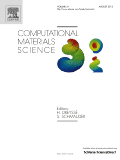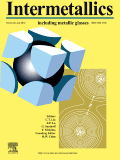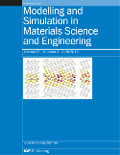
CALPHAD-COMPUTER COUPLING OF PHASE DIAGRAMS AND THERMOCHEMISTRY
Scope & Guideline
Innovating Connections Between Computation and Chemistry
Introduction
Aims and Scopes
- Thermodynamic Modeling and Phase Diagrams:
The journal emphasizes the development and application of thermodynamic models for calculating phase diagrams across various material systems, including metals, ceramics, and complex alloys. - Integration of Experimental and Computational Techniques:
A significant focus is placed on combining experimental investigations with computational methods, such as first-principles calculations and machine learning, to validate and enhance thermodynamic assessments. - Multi-Component and High-Entropy Alloys:
Research often explores multi-component systems, particularly high-entropy alloys, highlighting the challenges and methodologies for assessing their complex phase behavior. - Machine Learning and Data-Driven Approaches:
The journal is increasingly incorporating machine learning techniques to predict thermodynamic properties and phase transformations, reflecting a trend towards data-driven methodologies. - Kinetic and Diffusion Studies:
In addition to equilibrium thermodynamics, there is a focus on kinetic studies, including atomic mobilities and diffusion coefficients, which are critical for understanding material behavior during processing.
Trending and Emerging
- High-Throughput Computational Methods:
The use of high-throughput computational techniques is on the rise, enabling rapid screening of material properties and phase behaviors across vast compositional spaces, particularly in high-entropy alloys. - Machine Learning in Thermodynamics:
The integration of machine learning algorithms to predict phase stability and thermodynamic properties is gaining traction, showcasing a significant shift towards data-driven approaches in materials modeling. - Interfacial and Kinetic Studies:
Research focusing on interfacial phenomena and kinetic aspects of phase transformations is emerging, reflecting an increasing recognition of the importance of kinetics in material performance and processing. - Complex Multi-Component Systems:
There is a clear trend towards studying complex multi-component systems, including those relevant to advanced applications such as energy materials and high-performance alloys, indicating a broader scope of materials being investigated. - Sustainability and Environmental Impact:
Emerging themes also include the exploration of materials with lower environmental impact, aligning with global sustainability goals, which is becoming increasingly relevant in thermodynamic assessments.
Declining or Waning
- Traditional Unary and Binary Systems:
Research on simpler unary and binary phase diagrams appears to be declining, as the community increasingly shifts focus towards complex multi-component systems and high-entropy alloys. - Basic Thermodynamic Properties:
There is a noticeable reduction in studies solely dedicated to basic thermodynamic properties of well-known materials, as newer research emphasizes more complex interactions and advanced modeling techniques. - Static Phase Diagrams Without Kinetic Considerations:
Papers focusing exclusively on static phase diagrams without considering kinetic factors or real-time processing conditions are becoming less prevalent, as the field recognizes the importance of dynamic behavior in phase transitions.
Similar Journals

Transactions of FAMENA
Exploring New Dimensions in Mechanics of MaterialsTransactions of FAMENA is a prestigious academic journal dedicated to the field of mechanics of materials, published by the University of Zagreb Faculty of Mechanical Engineering and Naval Architecture. With its ISSN and E-ISSN of 1333-1124, this journal serves as a vital platform for researchers, professionals, and students alike, promoting the dissemination of innovative research and advancements in material mechanics. Boasting an impact factor that places it in the Q3 category for Mechanics of Materials in 2023, the journal currently ranks at 245 out of 398 in the Scopus database, highlighting its contribution to the academic community and its growing influence within the field. Since its inception in 2002, Transactions of FAMENA has aimed to bridge theoretical and practical aspects of mechanics, providing an invaluable resource for those engaged in engineering and material sciences. Although it operates under a traditional access model, the insights and findings presented in its pages remain crucial for advancing knowledge and fostering collaboration amongst scholars worldwide.

JOURNAL OF MOLECULAR LIQUIDS
Innovating the Future of Molecular Liquid StudiesJOURNAL OF MOLECULAR LIQUIDS, published by Elsevier, is a premier academic journal focused on the intricate nature of molecular liquids, spanning foundational to applied research. With an ISSN of 0167-7322 and an E-ISSN of 1873-3166, this journal has established its significance in various fields, achieving Q1 rankings across atomic and molecular physics, condensed matter physics, and materials chemistry, among others, as of 2023. The journal’s broad scope, covering studies from theoretical frameworks to experimental applications, serves as a vital platform for disseminating innovative research findings while advancing our understanding of molecular interactions and dynamics. With a strong position in Scopus rankings and high impact factors, it is a trusted resource for researchers, professionals, and students alike, seeking comprehensive insights into molecular liquids. As a journal that thrives on pioneering energy, the JOURNAL OF MOLECULAR LIQUIDS is essential for anyone wishing to remain at the forefront of research in this dynamic field.

COMPUTATIONAL MATERIALS SCIENCE
Advancing the Frontiers of Material InnovationCOMPUTATIONAL MATERIALS SCIENCE is a prestigious academic journal dedicated to the dissemination of innovative research in the field of computational materials science, emphasizing the interplay between computational methodologies and materials engineering. Published by ELSEVIER in the Netherlands, this journal showcases high-impact articles that contribute significantly to the understanding of material properties through computational techniques. As evidenced by its 2023 Scopus Rankings, which place it in the top quartiles across multiple disciplines including Computer Science, Materials Science, and Physics and Astronomy, it is a vital resource for researchers, professionals, and students alike. With a focus on advancing scientific knowledge and practical applications, COMPUTATIONAL MATERIALS SCIENCE aims to bridge the gap between theoretical investigations and experimental validation. Explore a wealth of cutting-edge research designed to inspire the next generation of innovations in materials science through this esteemed publication.

PHYSICS AND CHEMISTRY OF MINERALS
Unveiling the Secrets of Earth's Building BlocksPHYSICS AND CHEMISTRY OF MINERALS, published by SPRINGER, is a premier journal dedicated to advancing the understanding of the physical and chemical properties of minerals, their interactions, and their significance in various geological processes. With an ISSN of 0342-1791 and an E-ISSN of 1432-2021, this journal serves as a vital resource for researchers and professionals in geochemistry and petrology, as well as materials science. Reflecting the journal's commitment to quality scholarship, it has achieved Q3 rankings in both Geochemistry and Petrology, and Materials Science (miscellaneous) categories. Established in 1977 and continuing through 2024, the journal has consistently provided a platform for high-impact research, fostering collaboration and innovation in the field. Located in Germany and reaching a global audience, PHYSICS AND CHEMISTRY OF MINERALS is instrumental for students, academics, and industry experts looking to stay at the forefront of mineral research and applications.

TRANSACTIONS OF THE INDIAN INSTITUTE OF METALS
Cultivating knowledge for a sustainable future in metallurgy.TRANSACTIONS OF THE INDIAN INSTITUTE OF METALS is a premier journal published by Springer India, dedicated to the field of metallurgy and materials science. Established in 1969, this journal serves as a vital platform for researchers and professionals to disseminate their findings on metals and alloys, showcasing innovative studies and experimental techniques. With an impressive impact factor and categorized in the Q2 quartile for metals and alloys as of 2023, it ranks 70 out of 176 in its field according to Scopus, placing it in the 60th percentile. The journal maintains a robust reputation for fostering academic excellence, thus attracting contributions from both established and emerging scholars. Though not an open access publication, its well-curated content remains a crucial resource for advancing knowledge and technology in metallurgy. The journal's extensive operational history, particularly during notable converged years, underscores its enduring significance in the scientific community.

INTERMETALLICS
Shaping the Future of Mechanical EngineeringINTERMETALLICS, a prestigious journal published by ELSEVIER SCI LTD in the United Kingdom, has been a vital resource in the fields of Materials Science, Mechanical Engineering, and Chemistry since its inception in 1993. Renowned for its rigorous peer-review process and commitment to high-quality research, this journal enjoys an impressive position within the top quartile (Q1) rankings of its categories, signifying its influence and esteem in the academic community. With a particular emphasis on the study of intermetallic compounds and their applications, INTERMETALLICS attracts groundbreaking research and innovative contributions that push the boundaries of knowledge in metals and alloys, as well as mechanics of materials. Researchers looking for a platform to disseminate cutting-edge findings will find this journal an exemplary choice, further enhanced by its commendable Scopus rankings that illustrate its widespread recognition and relevance. Though it does not currently offer Open Access options, the journal remains committed to advancing the field through selective publication of impactful research, making it an essential reference for researchers, professionals, and students alike interested in the dynamic interplay between materials and engineering.

DOKLADY PHYSICAL CHEMISTRY
Pioneering Research in Physical Chemistry Since 1996DOKLADY PHYSICAL CHEMISTRY is a prominent peer-reviewed journal published by MAIK NAUKA/INTERPERIODICA/SPRINGER, focusing on advancements and research in the field of Physical and Theoretical Chemistry. With the ISSN 0012-5016 and E-ISSN 1608-3121, this journal serves as a vital platform for researchers and practitioners to disseminate their findings and insights from 1996 to the present. Despite its current Q4 ranking in the 2023 category of Physical and Theoretical Chemistry, the journal has shown significant potential for visibility and engagement within the academic community, ranking #149 out of 189 in its respective field according to Scopus metrics, highlighting its dedicated readership. While the journal is not open access, it remains an essential resource for those seeking in-depth research articles, reviews, and commentary within this dynamic discipline. As the field continues to evolve, DOKLADY PHYSICAL CHEMISTRY plays a crucial role in fostering scientific dialogue and collaboration among researchers, professionals, and students worldwide.

CONTRIBUTIONS TO MINERALOGY AND PETROLOGY
Cultivating Knowledge in Geophysics and PetrologyCONTRIBUTIONS TO MINERALOGY AND PETROLOGY, published by SPRINGER, is a premier journal in the fields of geochemistry, petrology, and geophysics, boasting an impressive impact factor that reflects its status as a leader in the discipline. With a history spanning from 1966 to 2024, this journal has consistently provided a platform for high-quality research that influences our understanding of earth materials and processes. Ranked in the top quartile (Q1) in both geochemistry and petrology, as well as geophysics, it stands out with Scopus rankings of #24 out of 165 in Geophysics and #37 out of 154 in Geochemistry and Petrology, indicating its critical role in advancing scientific knowledge. As a vital resource for researchers, professionals, and students alike, the journal invites contributions that foster collaboration and innovation in the study of minerals and rocks. Although it does not currently offer open access, its scholarly rigor and relevance to contemporary issues ensure it remains an indispensable part of the academic discourse within this field.

MODELLING AND SIMULATION IN MATERIALS SCIENCE AND ENGINEERING
Unveiling the Mechanics of Material PerformanceMODELLING AND SIMULATION IN MATERIALS SCIENCE AND ENGINEERING, published by IOP Publishing Ltd, serves as a vital resource for researchers, professionals, and students engaged in the multifaceted fields of materials science, condensed matter physics, and computational mechanics. Since its inception in 1992, this journal has been committed to advancing knowledge through high-quality research articles, reviews, and simulations that explore complex interactions within materials. With an impressive Scopus rank in multiple categories, including Q2 in Materials Science and Mechanics of Materials, it reflects its significant influence and relevance in the academic community. Though not an open-access journal, it provides critical insights and developments in modeling techniques and simulations aimed at improving material performance and understanding thermodynamic processes, making it an essential read for those at the forefront of materials innovation. As it continues to expand its scope and reach into 2024 and beyond, MODELLING AND SIMULATION IN MATERIALS SCIENCE AND ENGINEERING remains a key platform for disseminating groundbreaking research that shapes the future of the discipline.

Archives of Thermodynamics
Pioneering Research in Thermodynamic SystemsArchives of Thermodynamics is a reputable journal dedicated to the field of thermodynamics, published by the esteemed POLISH ACADEMY OF SCIENCES. With a robust history since its inception in 2003, this journal serves as a critical platform for disseminating high-quality research aimed at advancing knowledge and technology in thermodynamic systems and processes. Recognized for its contribution to the field, it holds a Q3 ranking in the Physics and Astronomy (miscellaneous) category as of 2023, with a respectable Scopus rank of #148 out of 243, placing it within the 39th percentile. Although it follows a traditional access model, the journal's commitment to scholarly excellence ensures that researchers, professionals, and students alike can benefit from its rich archives and ongoing discussions within the scientific community. Situated in Warsaw, Poland, the journal not only reflects a regional dedication to scientific progress, but also engages with global audiences interested in the evolving landscape of thermodynamic research.